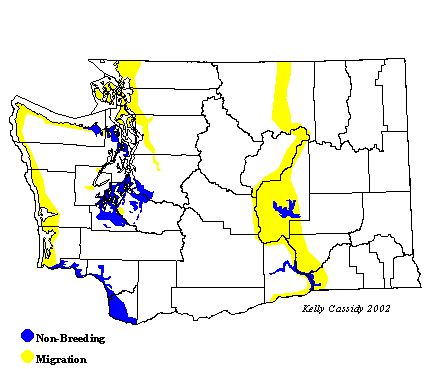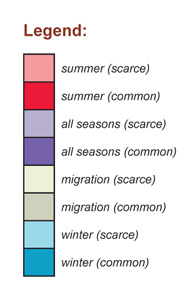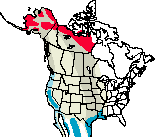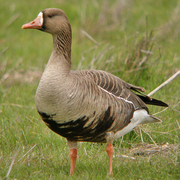Greater White-fronted Goose
General Description
The Greater White-fronted Goose is mottled brownish-gray overall with a black tail, white rump, white band at the tip of the tail, and bright orange legs. The belly has a varied pattern of large black splotches. Its name is derived from the white facial feathers around the base of the pinkish-yellow bill. The juvenile looks similar but lacks the white facial feathering and black markings on the belly.
Habitat
Greater White-fronted Geese nest on marshy ponds in the tundra or taiga. They winter in open country in mild climates in habitat with shallow fresh or salt water near agricultural fields.
Behavior
The Greater White-fronted Goose grazes while walking on land, and dabbles when in the water. Social most of the year, this goose is territorial during the breeding season.
Diet
In the winter, seeds and waste grain are the staple of the diet. Stems and roots become more important sources of food during the breeding season. These geese also eat some invertebrates.
Nesting
The Greater White-fronted Goose doesn't usually breed until 3 years of age. The female builds a shallow depression lined with plant material and down in a sheltered spot near the water. She lays and incubates 3 to 6 eggs for 22 to 27 days. The young walk and swim almost immediately after hatching, and both parents tend them, although they feed themselves. First flight is typically between 38 and 45 days, but the young remain with the parents for at least the first year, and often maintain an association with the family for several years.
Migration Status
A long-distance migrant, the Greater White-fronted Goose relies on established migratory routes and stopover points on its way to wintering grounds in California and southern Oregon.
Conservation Status
The population of Greater White-fronted Geese has fluctuated. Pacific birds declined in the 1970s and 1980s, but increasing numbers have been wintering in western Washington in recent years. Hunting is a major factor controlling populations (but losses due to hunting can be managed). Habitat loss is a more difficult challenge. Large oil fields on the Alaskan Arctic coastal plain have degraded the wetlands in that area, potentially affecting nesting success of the Greater White-fronted Goose. The Tule Goose, a large, dark subspecies that nests in southern Alaska and winters in central California, makes up about 1% of the total population, but its status in the Pacific Northwest is poorly known.
When and Where to Find in Washington
Among the first fall migrants seen along Washington's outer coastline, Greater White-fronted Geese are common from late August to mid October and again from mid-April to mid-May on the coast. They are often seen in small, mixed-species flocks. They are also regularly seen during migration in freshwater habitats in eastern Washington as well, occurrence there somewhat later both spring and fall. The best time to see these geese is in early May. Leadbetter Point, Ridgefield National Wildlife Refuge (Clark County), and Grays Harbor (Grays Harbor County) are good spots to observe this species.
 Abundance
Abundance
| Ecoregion | Jan | Feb | Mar | Apr | May | Jun | Jul | Aug | Sep | Oct | Nov | Dec |
|---|---|---|---|---|---|---|---|---|---|---|---|---|
| Oceanic | ||||||||||||
| Pacific Northwest Coast | U | U | U | F | F | U | U | U | U | U | ||
| Puget Trough | U | U | U | F | U | U | F | F | U | U | ||
| North Cascades | ||||||||||||
| West Cascades | U | U | U | U | U | U | U | U | U | |||
| East Cascades | R | R | U | U | R | R | U | U | R | |||
| Okanogan | R | R | R | R | R | |||||||
| Canadian Rockies | ||||||||||||
| Blue Mountains | ||||||||||||
| Columbia Plateau | U | F | F | F | R | R | F | F | U | U |
Washington Range Map

North American Range Map


Family Members
 Fulvous Whistling-DuckDendrocygna bicolor
Fulvous Whistling-DuckDendrocygna bicolor Taiga Bean-GooseAnser fabalis
Taiga Bean-GooseAnser fabalis Greater White-fronted GooseAnser albifrons
Greater White-fronted GooseAnser albifrons Emperor GooseChen canagica
Emperor GooseChen canagica Snow GooseChen caerulescens
Snow GooseChen caerulescens Ross's GooseChen rossii
Ross's GooseChen rossii BrantBranta bernicla
BrantBranta bernicla Cackling GooseBranta hutchinsii
Cackling GooseBranta hutchinsii Canada GooseBranta canadensis
Canada GooseBranta canadensis Mute SwanCygnus olor
Mute SwanCygnus olor Trumpeter SwanCygnus buccinator
Trumpeter SwanCygnus buccinator Tundra SwanCygnus columbianus
Tundra SwanCygnus columbianus Wood DuckAix sponsa
Wood DuckAix sponsa GadwallAnas strepera
GadwallAnas strepera Falcated DuckAnas falcata
Falcated DuckAnas falcata Eurasian WigeonAnas penelope
Eurasian WigeonAnas penelope American WigeonAnas americana
American WigeonAnas americana American Black DuckAnas rubripes
American Black DuckAnas rubripes MallardAnas platyrhynchos
MallardAnas platyrhynchos Blue-winged TealAnas discors
Blue-winged TealAnas discors Cinnamon TealAnas cyanoptera
Cinnamon TealAnas cyanoptera Northern ShovelerAnas clypeata
Northern ShovelerAnas clypeata Northern PintailAnas acuta
Northern PintailAnas acuta GarganeyAnas querquedula
GarganeyAnas querquedula Baikal TealAnas formosa
Baikal TealAnas formosa Green-winged TealAnas crecca
Green-winged TealAnas crecca CanvasbackAythya valisineria
CanvasbackAythya valisineria RedheadAythya americana
RedheadAythya americana Ring-necked DuckAythya collaris
Ring-necked DuckAythya collaris Tufted DuckAythya fuligula
Tufted DuckAythya fuligula Greater ScaupAythya marila
Greater ScaupAythya marila Lesser ScaupAythya affinis
Lesser ScaupAythya affinis Steller's EiderPolysticta stelleri
Steller's EiderPolysticta stelleri King EiderSomateria spectabilis
King EiderSomateria spectabilis Common EiderSomateria mollissima
Common EiderSomateria mollissima Harlequin DuckHistrionicus histrionicus
Harlequin DuckHistrionicus histrionicus Surf ScoterMelanitta perspicillata
Surf ScoterMelanitta perspicillata White-winged ScoterMelanitta fusca
White-winged ScoterMelanitta fusca Black ScoterMelanitta nigra
Black ScoterMelanitta nigra Long-tailed DuckClangula hyemalis
Long-tailed DuckClangula hyemalis BuffleheadBucephala albeola
BuffleheadBucephala albeola Common GoldeneyeBucephala clangula
Common GoldeneyeBucephala clangula Barrow's GoldeneyeBucephala islandica
Barrow's GoldeneyeBucephala islandica SmewMergellus albellus
SmewMergellus albellus Hooded MerganserLophodytes cucullatus
Hooded MerganserLophodytes cucullatus Common MerganserMergus merganser
Common MerganserMergus merganser Red-breasted MerganserMergus serrator
Red-breasted MerganserMergus serrator Ruddy DuckOxyura jamaicensis
Ruddy DuckOxyura jamaicensis

